Of all the commonly available creatures out there for your aquarium Crayfish are some of the most challenging for the community tank. Large, often bad tempered, and always hungry, Crayfish are either going to grab something or eventually be eaten by larger fish. So what are some of the best tank mates for Crayfish?
10 Compatible Crayfish Tank Mates
Here are 10 of our favorite crayfish tank mates that you should consider:
White Cloud Minnow
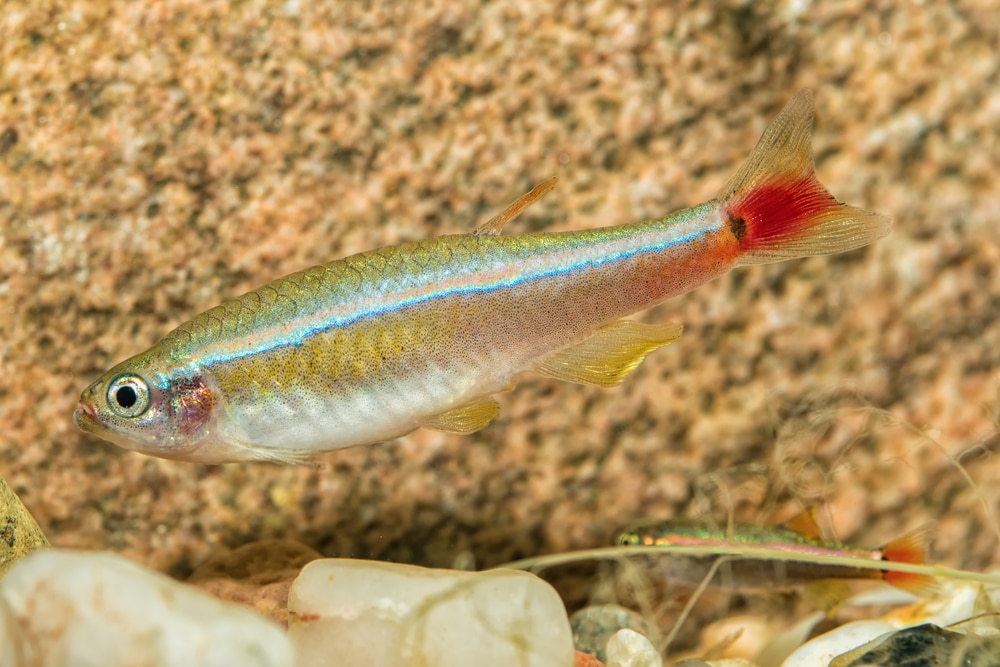
Since Crayfish are North American natives aquarists don’t always need to keep them in heated tanks. I don’t recommend keeping Crayfish with Goldfish because even larger fish risk getting caught by their claws if the Crayfish gets too hungry or aggressive.
Instead, the Asian White Cloud Minnow is a great substitute for not only Goldfish but other small schooling fish for your coldwater aquarium. They are small and peaceful yet stick mostly to the middle and upper water column. When searching for Crayfish tank mates we want to avoid fish that stick to the bottom unless they are large and aggressive enough to fend off the Crayfish.
White Cloud Minnows are also omnivorous and will eat just about any plant or animal material offered, just like Crayfish. Plant-based prepared formulas, fresh and frozen foods, and small standard pellets are all happily accepted by them!
- Scientific Name: Tanichthys albonubes
- Origin: Southern China & Northern Vietnam
- Size: 1 to 1½ inches
- Temperament: Peaceful; Schooling
Red Tail Shark
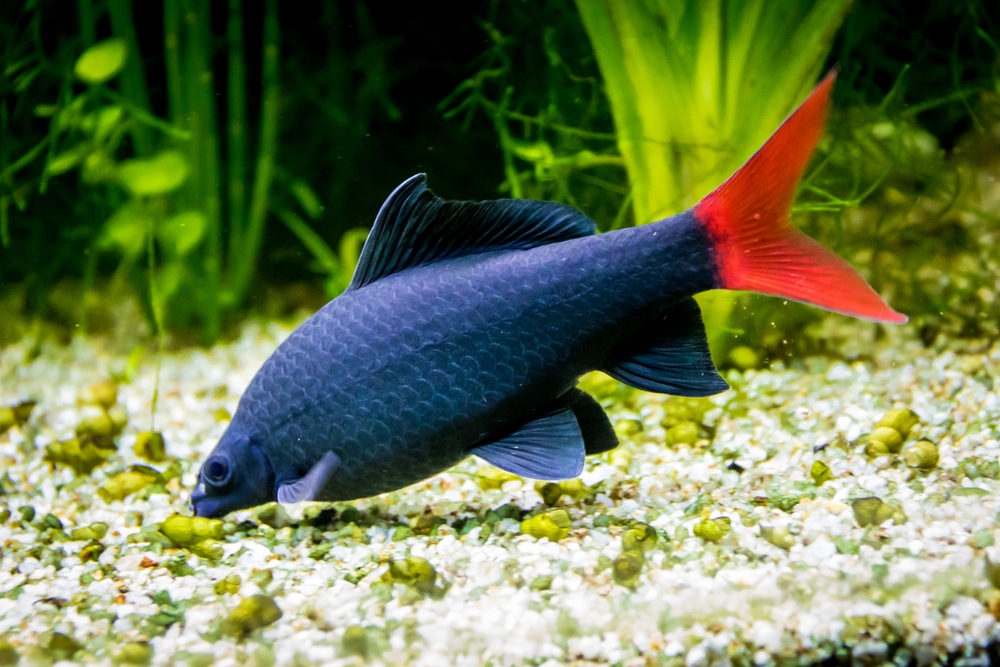
There are several species of freshwater sharks that can be found in the trade. None of them are true sharks as they aren’t even distantly related but they have a similar active nature, forked tail, and tall dorsal fin.
The Red Tail Black Shark is one of the few bottom dwellers that can live alongside a non-Dwarf Crayfish so long as your shark is larger than it. Red Tail Sharks are territorial and aggressive in their own right and need to be given a cave or driftwood hollow to call their own.
Red Tail Sharks are much less aggressive when they have turf to defend, otherwise they tend to claim the entire tank bottom as their own. The closely related Rainbow Shark (Epalzeorhynchos frenatum) is much less aggressive. But it’s also much thinner and more likely to be bullied or eaten by a Crayfish.
- Scientific Name: Epalzeorhynchos bicolor
- Origin: Thailand
- Size: 6 inches
- Temperament: Aggressive; Territorial
Hatchetfish
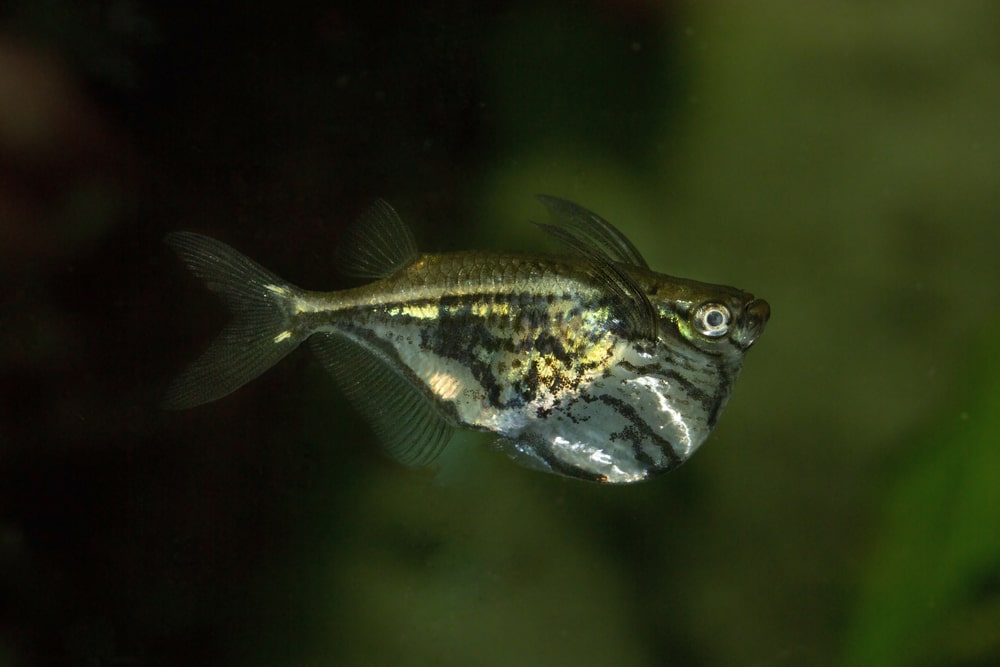
Since Crayfish are typically bottom dwelling menaces one of the best ways to ensure their tank mates remain safe is to choose fish that stay at the top constantly!
Look for fish with laterally compressed heads and upturned mouths. These are adaptations that allow them to more easily pluck floating insects and other prey from the water’s surface.
Arowana, Guppies, and many Killifish display these traits and hang at the surface looking for food. However most of these aren’t good tank mates for Crayfish. Hatchetfish, on the other hand, are nearly perfect because they spend all of their time at the surface.
These small insectivores are closely related to Tetras, Silver Dollars, and even the fearsome Piranha. However they remain small and are extremely easy to care for, accepting a wide range of water chemistries and food offerings.
Be careful not to use a lid with large holes, however. Hatchetfish are easily startled and in nature, launch themselves out of the water to fly short distances on their massive pectoral fisn!
- Scientific Name: Gasteropelecidae family
- Origin: South America
- Size: 2-3 inches
- Temperament: Peaceful; Schooling
Danios
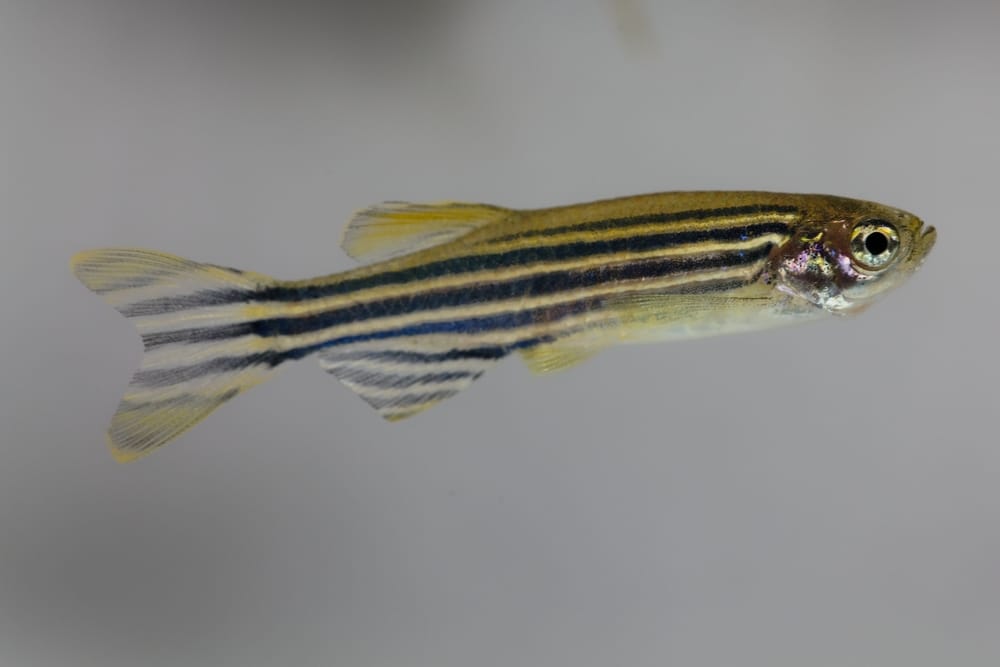
Danios are not only a great choice but one of the more colorful options in this list of tank mates. When it comes to Danios the larger species are best, with the Giant Danio taking the spotlight.
Adult Giant Danios are too large to be easily gripped by even an adult Crayfish. Danios are also mid to upper water column dwellers and will rarely be anywhere near a bottom dwelling crustacean.
Danios are very similar in habit to Tetras however Tetras spend more time in the middle to lower water column, putting them at greater risk of becoming Crayfish food. Danios are also hardier in the cooler water Crayfish prefer and breed readily in most aquaria!
- Scientific Name: Danio sp.
- Origin: South Asia
- Size: 1-5 inches
- Temperament: Peaceful; Schooling
Golden Wonder Killifish
Most Killifish are both too small and too close to the bottom to live for long next to a hungry Crayfish. However many of them are good sized and tend to stick to the surface – and the Golden Wonder Killifish is one of the most intensely colored.
Larger Killifish as a whole make good Crayfish tank mates because they are too fast and bulky to be easily snatched. Remember that large Killifish are predators in their own right; an adult Golden Wonder Killi will gladly snack on nano fish like Chili Rasboras and even young Guppies.
Other good Killifish include the 5-6 inch Blue Gularis (Fundulopanchax sjoestedti) and 3 inch American Flagfish (Jordanella floridae – with smaller Crayfish).
- Scientific Name: Apolcheilus lineatus
- Origin: South Asia
- Size: 3-4 inches
- Temperament: Peaceful
Severum
Cichlids as a group are some of the most difficult fish to match with Crayfish. They are either too small (Rams and Apistogramma), too delicate (Angelfish), or they will gladly eat your Crayfish (Oscars). As this video shows, when hungry, Crayfish get quite grabby but the right Cichlids are usually able to evade them.
Medium sized robust species are the best match for boisterous crustaceans. I recommend Severums because at 6-8 inches they are far too large to be eaten yet have mouths too small to return the favor.
Severums are subdued in color unless you run into the Gold morph. These South American natives prefer soft water and elevated temperatures (78-83F). While semi-aggressive they are mild-mannered for cichlids and can co-exist with most similarly sized fish.
Other Cichlids that pair well with Crayfish include adult Convict Cichlids (Amatitlania nigrofasciata) and Firemouths (Thorichthys meeki).
- Scientific Name: Heros severus
- Origin: South America
- Size: 6-8 inches
- Temperament: Peaceful to Semi-Aggressive
African Butterflyfish
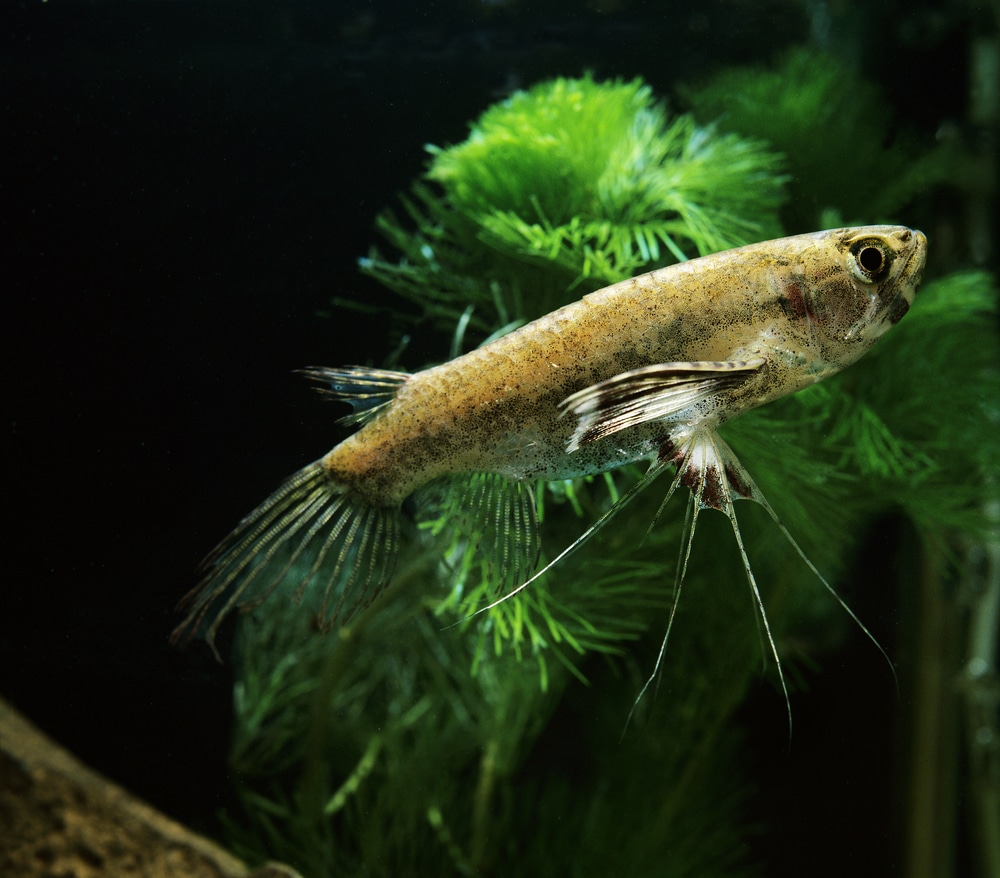
These shy predators lurk at the surface mimicking fallen leaves and floating branches. If a small insect happens to hit the water it disappears instantly with a splash. Small fish thinking they’ve found a lucky bit of cover will also be quickly eaten by the camouflaged Butterflyfish.
As you might guess by looking at them African Butterflyfish are closely related to Arowanas. However unlike their giant cousins they won’t grow nearly large enough to eat an adult Crayfish.
Since they inhabit entirely different zones of the aquarium the two species will rarely interact with one another. Keep African Butterflyfish in heavily planted tanks with fish too large to be easily eaten. They prefer soft water and floating plants like water lettuce for cover as they wait for crickets, guppies, and other live, meaty prey items.
I prefer using Indian Almond leaves for fish that prefer soft water. They are rich in tannins and humic acids that help buffer the pH towards acidity and give the water a natural tea color that’s perfect for biotope aquascapes.
- Scientific Name: Pantodon buchholzi
- Origin: West Africa
- Size: Up to 6 inches
- Temperament: Peaceful; Predatory
Tinfoil Barb
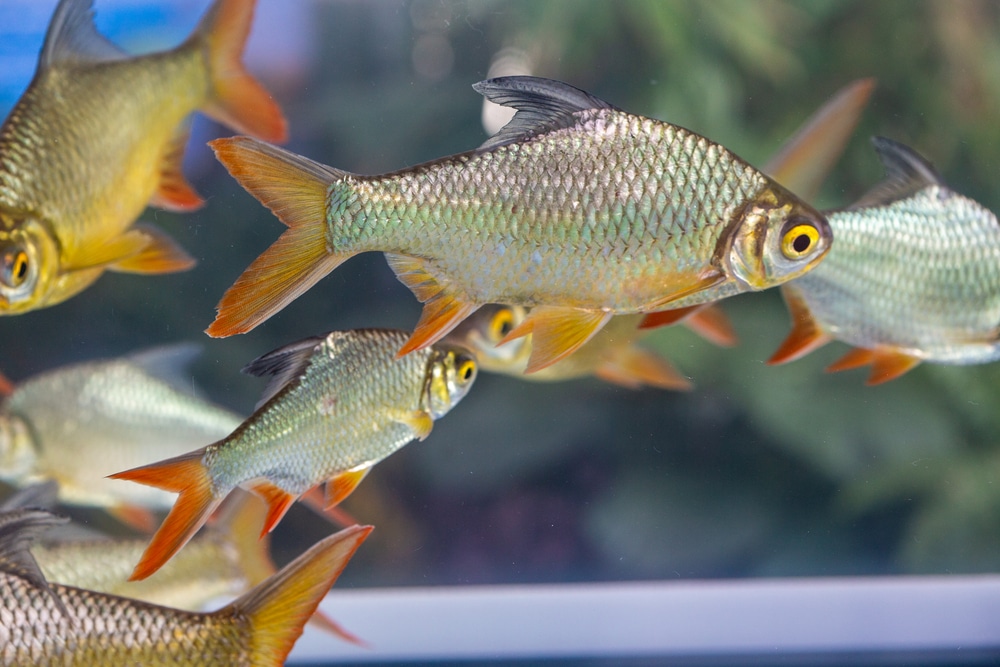
It’s hard to recommend most Barbs as Crayfish tank mates. While they are typically very active, schooling fish, Barbs are smaller and lurk in the areas Crayfish tend to be. And at night they sleep on the bottom, making them an easy target if you haven’t fed your Crayfish.
Robust species will do just fine, however. Larger Barbs include the Denison Barb (Sahyadria denisonii – 4-5 inches), Zebra Barb (Puntius johorensis – 5-6 inches), and the largest of them all: the Tinfoil Barb.
Considering how large and active these fish are, I don’t think they should be so easy to find in pet stores. They will outgrow the majority of aquariums people have. However if your final home will be 125 gallons in size or larger, these are some of the best dither fish you can own.
Much like Silver Dollars, Tinfoil Barbs lean heavily towards the vegetarian side. They love parboiled peas, soft plants like Elodea, and other greens to go along with standard prepared foods!
- Scientific Name: Barbonymus schwanenfeldii
- Origin: Southeast Asia
- Size: 10-14 inches
- Temperament: Peaceful; Schooling
Bala Shark
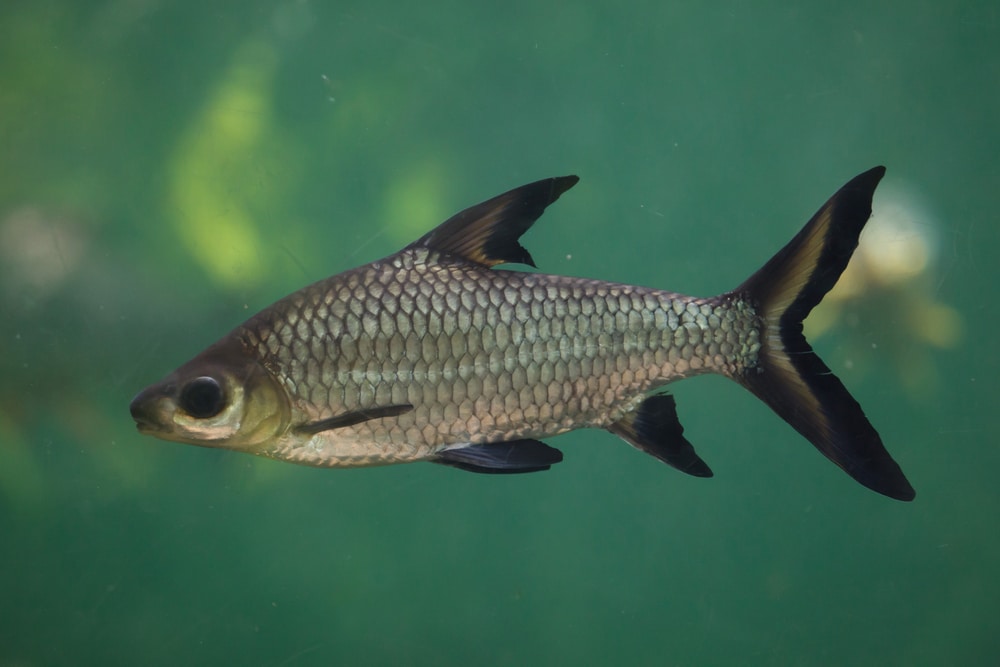
And here we have yet another freshwater “shark”. Like the Red Tail Shark this one is also a large Cyprinid and thus related to Danios, Goldfish, and Barbs.
And being a Cyprinid you can expect it to have the same traits as its cousins: cold tolerant, schooling, and omnivorous (eats both plants and animals). However, Bala Sharks have a few special considerations of their own.
For one, they get huge; potentially even larger than Tinfoil Barbs. Bala Sharks are also famously skittish and will slam into a tank lid or side if they don’t have enough space to roam free.
However they almost never swim near the bottom and their size gives them added protection against lurking Crayfish. Just make sure you’re providing them with their own kind to school with and at least 125 gallons of space to swim in as adults.
- Scientific Name: Balantiocheilos melanopterus
- Origin: Malay Peninsula & Indonesia
- Size: 14-18 inches
- Temperament: Peaceful; Schooling
Other Crayfish
Crayfish are especially strange because their own kind are both the best and worst tank mates for them! On the one hand, Crayfish are immune to the claws of their own kind and will typically avoid one another as they are highly territorial.
On the other hand, they are at their most vulnerable when moulting; like all animals with a rigid exoskeleton, Crayfish have to shed their old skin as they grow. Here’s some well-timed footage detailing the process!
However during the process and afterwards for a few hours they are exhausted and soft-bodied. Other Crayfish can sense this weakness and often pounce on their own kind to get an easy meal! Make sure there’s plenty of space for molters to hide, preferably in a burrow, and that your Crayfish are of similar size.
- Scientific Name: Astacoidea superfamily
- Origin: Worldwide
- Size: 1-24 inches
- Temperament: Semi-Aggressive to Aggressive

